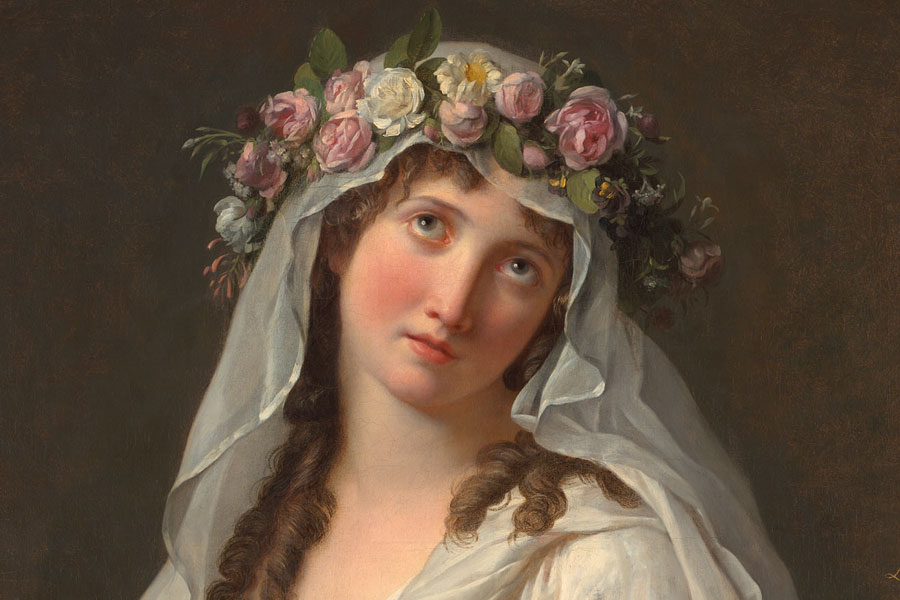Kandinsky, Munch, Richter highlight modern art auctions in London
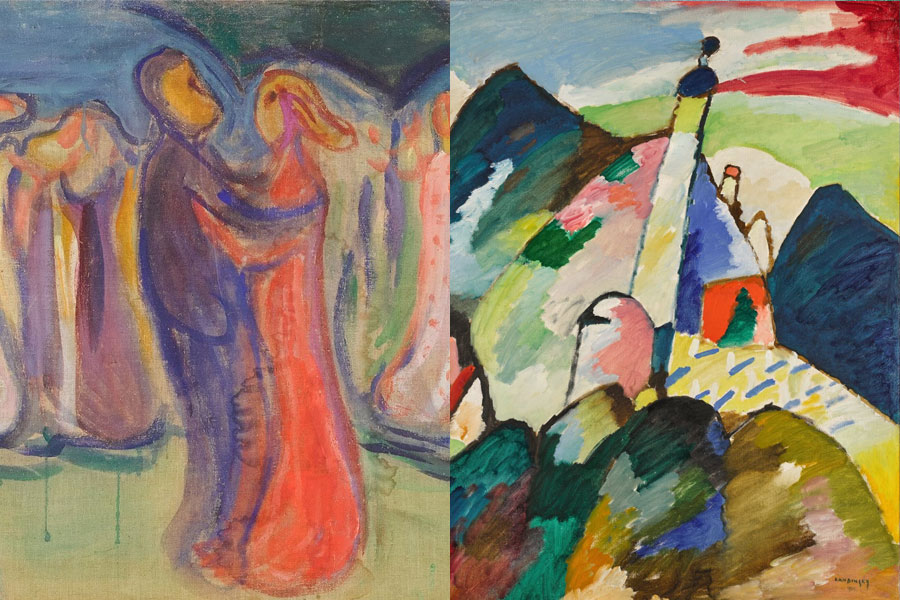
A review of the modern art auctions organised by Christie’s, Sotheby’s and Phillips in London between 28 February and 3 March 2023.
By G. Fernández – theartwolf.com – Texts written between 11 and 17 February 2023 – Edited between 28 February and 2 March with the results of the auctions.
Modern and Contemporary Art auction at Sotheby’s London, 1 March 2023
In this series of auctions, Sotheby’s has managed to steal the limelight from its great rival, Christie’s, by offering a very strong group of paintings including important works by artists such as Kandinsky, Munch, and Gerhard Richter.

Image: Edvard Munch, “Dans på stranden (Reinhardt-frisen)” [Dance on the Beach (The Reinhardt Frieze)], 1906-07
The first “star” Sotheby’s announced for this auction was Edvard Munch‘s “Dans på stranden (Reinhardt-frisen)” [Dance on the Beach (The Reinhardt Frieze)], which has a pre-sale estimate of between £12 and £20 million. Painted in 1906-07, it is difficult not to relate this work to another painting -also a Munch, also a frieze, also a beach scene- sold two years ago -also at Sotheby’s, also in March, also in London- for £16.2 million: “Summer Day” or “Embrace on the Beach“: The Linde Frieze. Compared to it, the “Reinhardt Frieze” is much larger (90 x 402.6 cm compared to 90.5 x 194.9 cm) and somewhat more schematic. In the online catalogue, Sotheby’s has prepared an extensive and interesting, if somewhat confusing, essay which includes both logical references (such as Munch’s famous “Frieze of Life“) and rather more debatable ones, including Paul Gauguin’s “Where do we come from? Who are we? Where are we going?” and an “Annunciation” by Fra Angelico (???). The auctioneer, Helena Newman, started the auction at £9 million, and the painting was sold for £16.94 million.
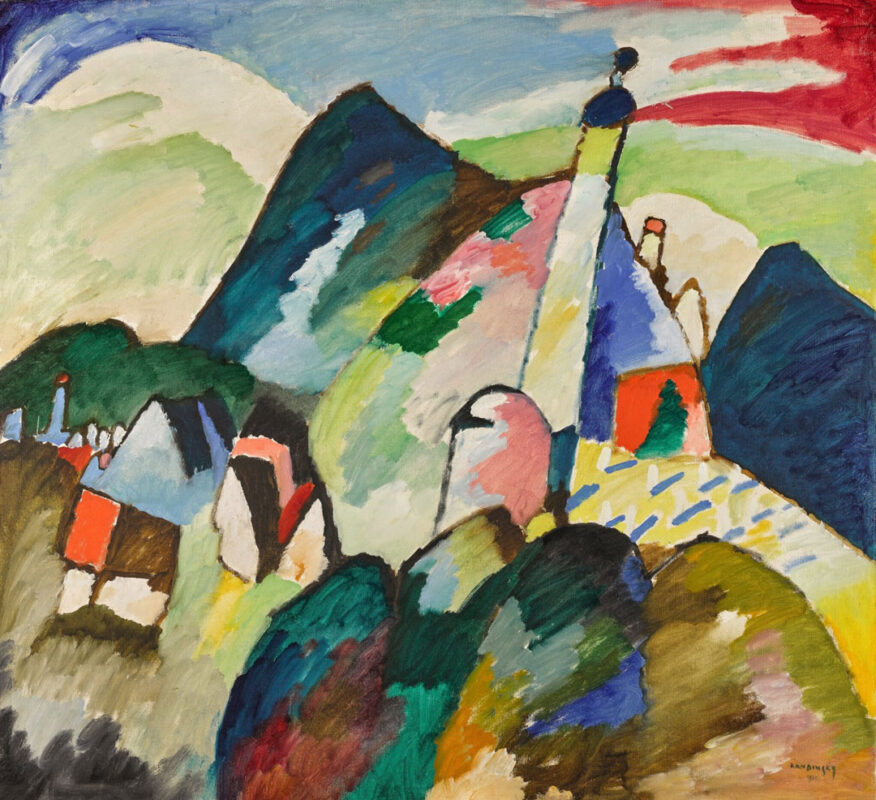
Image: Wassily Kandinsky, Murnau mit Kirche II” (Murnau with Church II)
Munch’s proto-Expressionism could serve as a prologue to the big star of Sotheby’s auction (and by extension, of this entire group of modern art sales in London), Wassily Kandinsky‘s “Murnau mit Kirche II” (Murnau with Church II), a work for which Sotheby’s has not published an estimate, but which some sources put at around $45 million.
Painted in 1910, the work belongs to a pivotal period in Kandinsky’s career, the year in which he wrote “On the Spiritual in Art” (his important artistic treatise to be published the following year), and in which his style moved more and more towards abstraction. In the catalogue of the work, Sotheby’s rightly states that “by 1910 when he painted ‘Murnau mit Kirche II’ he had found this new pathway and taken the first important steps on his journey towards abstraction. The breakthrough years of 1909-1911 would lead Kandinsky to develop a fully abstracted style that would form the basis of his career and make him one of the most influential artists of the twentieth century.”
If expectations are realised, “Murnau mit Kirche II” would beat the artist’s auction record, held since 2017 by the more abstract (and frankly far more important) “Bild mit Weissen Linien” (Painting with White Lines) from 1913, also sold by Sotheby’s for £33 million (about $42 million). It is difficult to predict whether this work will break the record. The recent (2018) sale of the less important “Improvisation auf Mahagoni” (also from 1910) for $24.2 million (considerably above its pre-sale valuation) invites optimism, but personally the first work that came to mind when I saw this painting was the 1911 “Herbstlandschaft”, which Christie’s put up for auction in 2011 with an optimistic pre-sale estimate of $20-25 million, and which failed to find a buyer, being sold the following year for just £5.5 million. Bids started at £28 million (!) and the hammer fell at £33 million for a final price of £37.2 million, a new auction record for the artist if inflation is not taken into account.
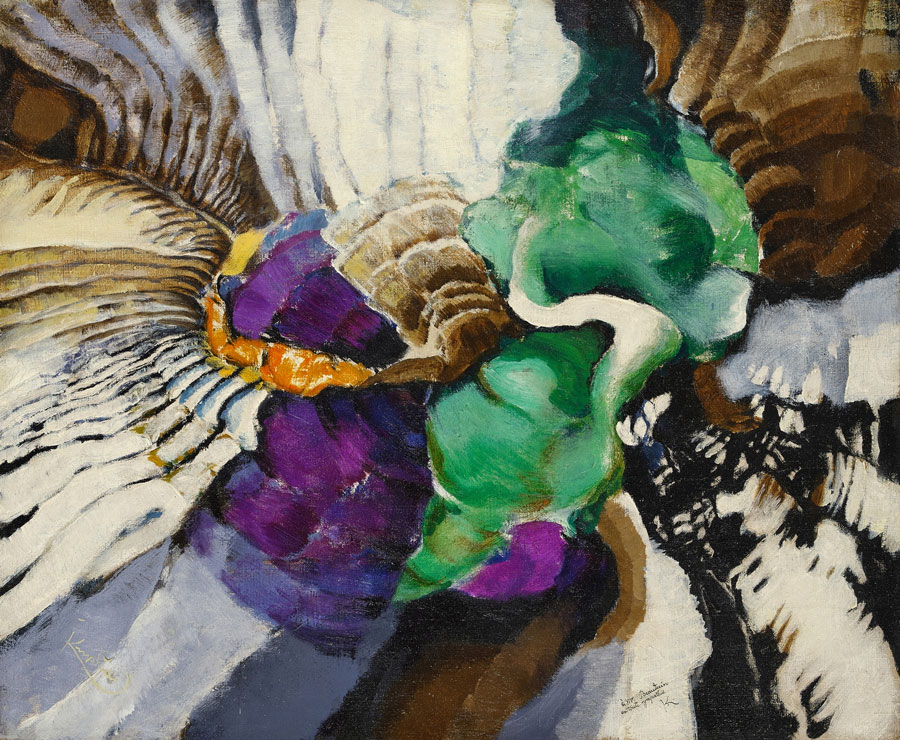
Image: František Kupka, “Complexe”, 1912
And if Munch’s proto-expressionism could serve as a prologue to Kandinsky’s full expressionism, the latter’s proto-abstraction could give way to the work that, in my opinion, deserves to be considered the “sleeper” or “potential bargain” of the auction: František Kupka‘s “Complexe” (1912). Kupka is one of the leading figures of early 20th century abstraction, although his fame among the general public has not reached that of names such as Delaunay or -of course- Kandinsky. His key works -those created between 1911 and 1914- very rarely appear on the market, and indeed I don’t recall any of them coming up for auction since “Formes allongées” was auctioned for €1.5 million at Christie’s Paris in October 2016. “Complexe” is a superb work, which should far exceed its pre-sale estimate of between £2.2 million and £2.8 million. Whether it will, of course, is another matter, as the art market doesn’t seem to be too enamoured of “intellectual” works like this one. The fact that it comes from the collection of Sean Connery could, however, add to its appeal for collectors. “Complexe” was sold for £4.64 million, an excellent result for an excellent painting.
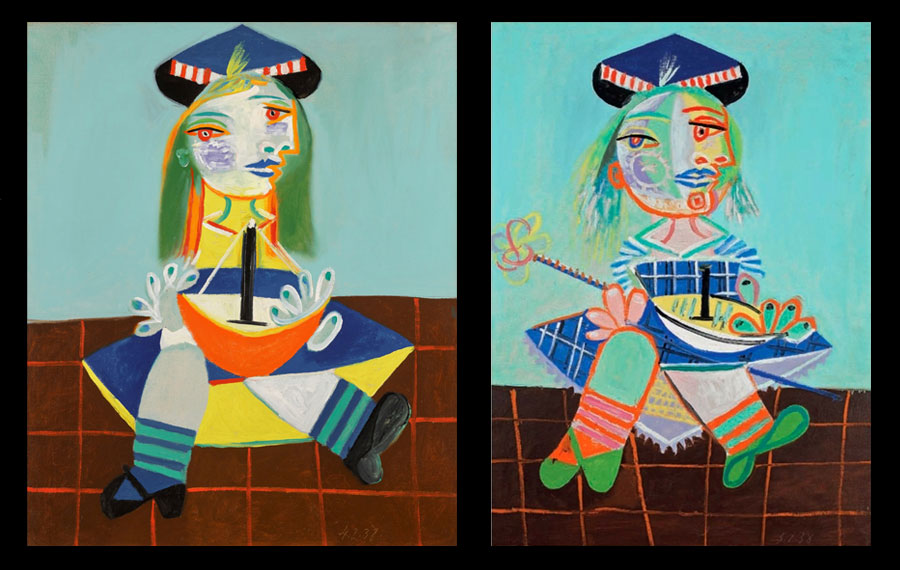
Image: Pablo Picasso, “Fillette au bateau, Maya” (left, included in this auction) / “La fille de l’artiste a deux ans et demi avec un bateau” (right, offered in 2009)
I admit that when I read the press release in which Sotheby’s announced that it was auctioning Pablo Picasso‘s “Fillette au bateau, Maya” (1938), stating that this was the first time the work had appeared at auction since 1999, I thought “Ha! False, you tried to sell it in 2009!” Once again, my arrogance led me astray, for this is not the same portrait of Maya (the painter’s daughter) that Sotheby’s offered at auction in May 2009, and which failed to find a buyer, a victim of a market in recession. Like that one, “Fillette au bateau, Maya” is not a masterpiece, but it is a good Picasso that should have no trouble reaching its pre-sale estimate of between £12 million and £18 million. Opening bid was £9 million, and the painting fetched £18.1 million in a surprisingly long bidding battle. And speaking of family portraits, Lucian Freud‘s “Ib Reading” comes up for auction with a pre-sale estimate of £15-20 million, and it was sold for £17 million.
Chronologically, the last of the big stars of Sotheby’s auction is Gerhard Richter‘s “Abstraktes Bild“, a work for which Sotheby’s expects to fetch in excess of £20 million. Painted in 1986, this huge (260 x 400 cm) abstraction sold in 2007 for $9.7 million, then a record for an abstract work by Richter. More recently (November 2018), another abstraction comparable in size (260 x 401 cm.) and complexity (although I always find it difficult to judge Richter’s Abstraktes Bilds) was auctioned at Sotheby’s for $32 million. The Richter was sold to a Chinese buyer for £24.2 million.
Elsewhere, there is a huge, late (too late to be interesting to me, though it is undeniably attractive) abstraction by Robert Delaunay that is expected to fetch £7-10 million (sold for £7.7 million), an “Odessa” by Philip Guston that has a surprisingly conservative pre-sale estimate (£2-3 million, sold for £4 million) and a portrait of Debbie Harry painted by Andy Warhol in 1980 that is of no interest except that it includes Debbie Harry, and anything that includes Debbie Harry is of some interest, one way or another. This painting, by the way, was auctioned in 2011 for almost $6 million, and now comes to auction with a pre-sale estimate of between £4 million and £6 million, which means that the work -taking inflation into account- may have lost value, something rather strange for a Warhol painting. The beautiful Debbie was sold for £6.6 million.
The Now Evening Auction at Sotheby’s, 1 March 2023
The auction dedicated to the cutting-edge artists is led by Cecily Brown‘s “The Nymphs Have Departed” (2014), which Sotheby’s defines as “an exquisite example of Cecily Brown’s seductive amalgamation of the figural and the abstract“, and which comes to auction with a pre-sale estimate of between £2.5 million and £3.5 million, which if fulfilled would mean that the painting has increased fivefold in value since it was auctioned in Hong Kong less than six years ago. And so it was, as the painting was auctioned for £3.4 million. Mention should also be made of Caroline Walker, a painter who has made a strong appearance at major auctions in the last two years and whose name -as we shall see- will appear several times in this series of auctions. With a visually characteristic and attractive style, reminiscent of the “Californian” works of David Hockney but also of George Bellows, the painter is represented by “In Every Dream Home“, a lovely painting which comes up for auction with a pre-sale estimate of between £100,000 and £150,000. This beautiful painting fetched an excellent £622,300. Overall, the auction was extremely successful, with most of the works fetching prices well above expectations. Special mention goes to Raghav Babbar’s “The Coal Seller” (2020-21), which sold for £609,600 against a pre-sale estimate of between £20,000 and £30,000.
Sotheby’s Modern and Contemporary Art Day Auction, 2 March 2023
As usual, daytime auctions do not include works with as much hype as the big evening auctions, but they are an appropriate habitat for finding potential bargains. This sale, for example, includes a small “Baigneur aux bras écartés” (1876) by Paul Cézanne, which comes to auction with a pre-sale estimate of between £250,000 and £300,000. Despite its simplicity and small size, the chance to acquire an example of Cézanne’s important series of “bathers” for less than half a million dollars seems a good opportunity. “Baigneur aux bras écartés” exceeded expectations and fetched £441,500. Starting prices of just over £100,000 include “Mixed Pickles” (1904), a pre-Fauvist painting by Alexei Jawlensky (sold for £228,600), and “Orphée Outrage” (1933), a Surrealist work by André Masson (unsold). Among the contemporary artworks on offer is a beautiful “Logged In” by the aforementioned Caroline Walker (£100,000 to £150,000, and sold for £381,000, one of Walker’s many successes in this series of auctions.) and “The Arrival of Spring in Woodgate, East Yorkshire in 2011 (twenty eleven) – 22 May“, a landscape by David Hockney which has a conservative pre-sale estimate of £80,000 to £120,000. This landscape by Hockney fetched only £82,550, and I have the impression that we will soon see this painting at an Art Basel or Frieze with a price of £200,000 or £300,000.
20th and 21st Century Art auction at Christie’s London, 28 February 2023
The “star” of Christie’s auction is “Femme dans un rocking-chair (Jacqueline)“, a late (1956) and large (194.5 x 130.1 cm) painting by Pablo Picasso, which carries a pre-sale estimate of £15-20 million, rather optimistic considering that the work sold for £2.5 million in 2007. As with most late Picassos, nothing about this painting catches my eye or motivates me to write about it, as is the case with two other Picassos also included in the auction, a monochrome “Femme assise dans un fauteuil tressé, en gris (Françoise)” (painted in 1953, pre-sale estimate £6-9 million) and “Mousquetaire I (Espagnol du XVllème siècle)” (painted in 1967, pre-sale estimate £4.5-6.5 million). None of these Picassos performed really well. “Femme dans un rocking-chair (Jacqueline)” was sold for £16.9 million, “Femme assise dans un fauteuil tressé, en gris (Françoise)“ fetched £5.3 million, and “Mousquetaire I (Espagnol du XVllème siècle)” was sold for £5.4 million. Honestly, none of them deserved better. Alongside these Picassos, the work with the highest pre-sale estimate is “L’Aqueduc du canal de Verdon au nord d’Aix“, a landscape painted by Paul Cézanne in 1882-83 (pre-sale estimate £6-9 million) which, far from being a great Cézanne, is nonetheless a work of some interest, which also has an excellent provenance, having been in the collection of Emil Hahnloser’s family for nearly a century. It sold for £7.15 million.
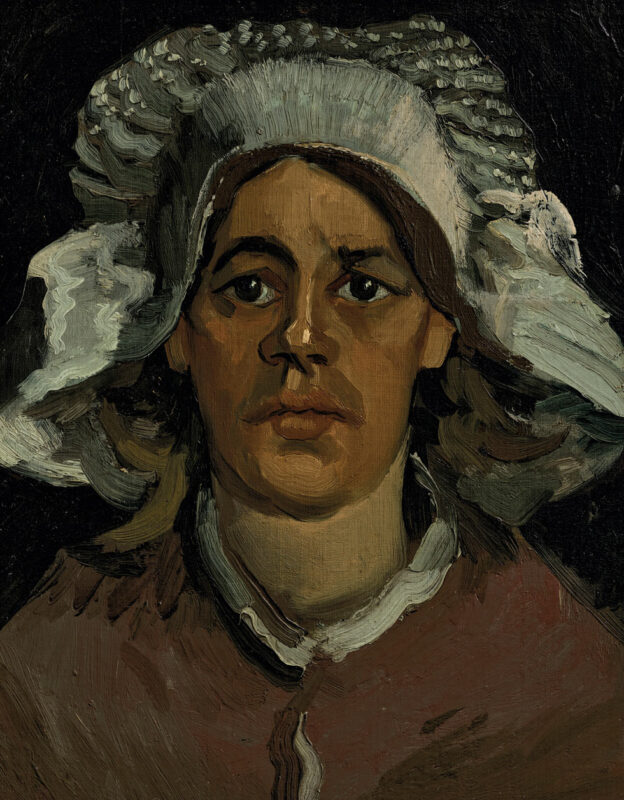
Image: Vincent van Gogh, “Kop van een vrouw (Gordina de Groot) (Head of a Woman [Gordina de Groot])”, 1885
One of the most interesting paintings in the auction is “Kop van een vrouw (Gordina de Groot) (Head of a Woman [Gordina de Groot])” -painted by Vincent van Gogh in Nuenen in the early spring of 1885- which carries a very modest pre-sale estimate of between £1 and £2 million. Clearly, the works Van Gogh painted prior to his stay in Paris and his contact with Japanese and Impressionist art do not enjoy the same critical fortune as his famous later paintings, but they are nonetheless interesting testimonies to the formation of one of the most studied, admired, sought-after and sometimes misunderstood figures in all of Western art. On the other hand, less than three years ago, Christie’s auctioned “Boerin met een kind op haar schoot (Peasant Girl with Child on Her Lap)“, also painted in Nuenen in the early spring of 1885, for $4.5 million. This Van Gogh fetched £4.84 million, a very deserved success but not a surprise -at least to me- since it is a very desirable work.
According to Ingo F. Walther (Vincent van Gogh, The Complete Works, 1997), during his period in Nuenen “Van Gogh dared, for longer and longer, to look into the eyes of his humble heroes (…) The inner dignity is present, all the integrity of an existence linked to nature that provides a real counterpart to the commissioned portraits, which flatter their own vanity with an artificial originality. These people are elevated, they emerge from their socially ordained anonymity, they assert their personality so insistently that the literature on Van Gogh soon tried to identify the people depicted: Gordina de Groot was called the most significant figure.”
Indeed, of all the peasants Van Gogh portrayed in Nuenen, Gordina de Groot is undoubtedly the one who appears in the largest number of works (including the famous “The Potato Eaters“) and she is -as the Van Gogh Museum, which owns another portrait similar to the one included in this auction, points out- the only one whose name is known. Although it appears cold and dark at first sight, this portrait of this young peasant girl is nonetheless an intimate work, full of sensitivity, a testimony to the special relationship between the painter and his model, which went so far as to lead to rumours that Vincent was the father of Gordina’s child, a rumour that Van Gogh always denied, and which Christie’s mentions in the catalogue of the work. Humble but dignified, unknown perhaps to the general public but of undeniable importance in the artist’s career, Gordina de Groot is chronologically the first in the list of the great models in Van Gogh’s career, a list that includes such famous names as Père Tanguy and Dr. Paul Gachet.
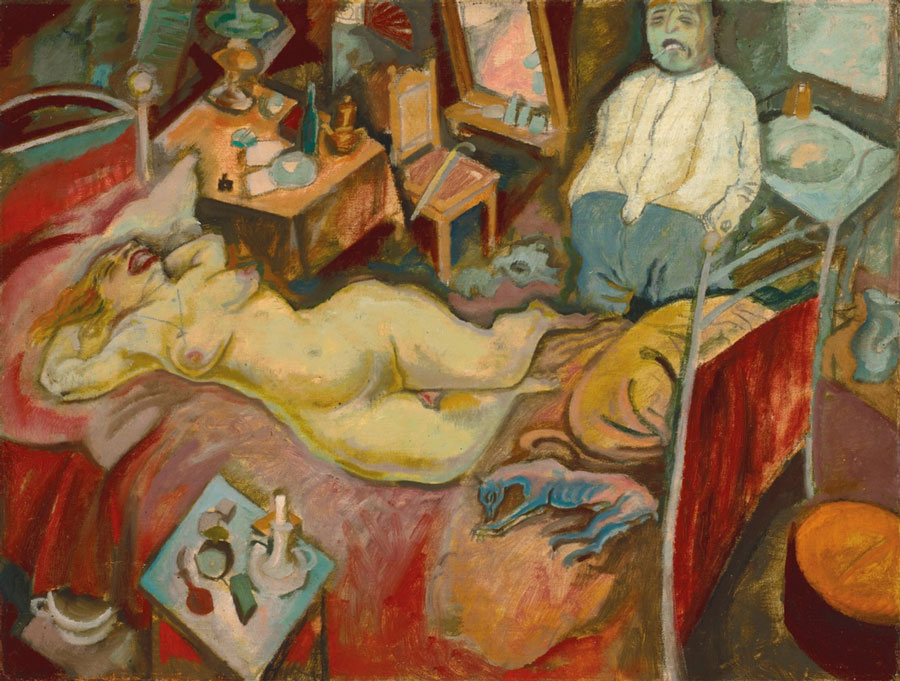
Image: George Grosz, “Paar im Zimmer”, 1915
Collectors interested in the great Expressionist “superstars” (Munch, Kandinsky) mentioned in the Sotheby’s auction could -and should- be also interested in a number of works of more modest estimation that Christie’s includes in the auction. For example, Ernst Ludwig Kirchner (co-founder and probably the most important of all the painters of the “Die Brücke” group) is represented by “Rothaarige (recto); Rosa Stilleben (verso)” (pre-sale estimate £2.4-4 million), a double work painted between 1913 and 1914; and by “Leuchtturm hinter Bucht” (pre-sale estimate £1.6-2.5 million), a landscape painted in 1912. Either of these two works could form a good pair with “Zwei Menschen im Freien“, painted in 1910 by Erich Heckel, another of Die Brücke’s co-founders (pre-sale estimate £600,000-800,000). An excellent “Paar im Zimmer” (1915) by George Grosz is offered with a very modest pre-sale estimate of between £700,000 and £1,000,000. Christie’s, which states that this work is one of George Grosz’s earliest surviving oil paintings, describes the painting as “an updated version of Edouard Manet’s and Paul Cezanne’s respective Olympias“. And to end this Expressionist collection (in some way, to “kill” Expressionism), nothing better than the acid and merciless gaze of Otto Dix, whose watercolour entitled “Sadisten gewidmet” (painted in 1922, pre-sale estimate £500,000-700,000) looks like a missing link between the Marquis de Sade and the Velvet Underground. “Nobody wants to look at it. What is it all supposed to mean? These old whores and the old, worn out women, and of life is cares? It doesn’t make anybody happy. No gallery wants to exhibit it. Why do you even bother to paint it?” Otto Dix wrote. Deliberately unpleasant, crude and irreverent, “Sadisten gewidmet” is inevitably fascinating. The Grosz failed to sell and the Dix sold for just £252,000, the biggest head-scratchers of the auction!
Contemporary works include Ewa Juszkiewicz‘s “Sisters” (2014), based on a group portrait by Swiss painter Anton Graff, which has a pre-sale estimate of between £300,000 and £500,000 (it sold for £630,000), same than Adrian Ghenie‘s “Pie Fight Study” (2012) (sold for £352,800). “The Shadow of Imana“, a 2018 self-portrait by Amoako Boafo has a pre-sale estimate of between £250,000 and £350,000, which could easily be exceeded considering the artist’s recent surge in popularity. The work sold for £504,000, double its more conservative pre-sale estimate, and yet I have the impression (almost certainty) that this is a work that will be worth more (much more) in five to ten years’ time. Also included is the aforementioned Caroline Walker, whose interesting “The Puppeteer” -painted in 2013- carries a pre-sale estimate of between £150,000 and £200,000. It sold for a formidable £693,000, and yet it was not the most positive surprise of the auction. That honour goes to Michaela Yearwood-Dan’s “Love Me Nots” (2021), the first lot of the auction, which sold for £730,800 against an initial estimate of just £40,000 to £60,000.
The Art of the Surreal auction at Christie’s London, 28 February 2023
The now customary auction of Surrealist art offers few surprises, led by René Magritte, whose “Le retour” returns (pun intended) to the market almost 20 years later. Painted in 1950, this small gouache has a pre-sale estimate of £4-6 million, ten times higher than the one it carried in the 2004 sale, when it fetched almost £1 million. It sold for a very respectable £6.1 million. “Portrait of Doctor Ignacio Chávez” (1957), an unusually large work by Remedios Varo, comes to auction with a pre-sale estimate of £2.5 to £3.5 million (it fetched an also a very respectable £3.8 million). The work could pair well with either of two large works by Leonora Carrington also from the same San Francisco Bay Area collection: “Quería ser Pájaro (I Wanted to be a Bird)” (1960, £900,000 to £1.2 million, sold for £882,000) and “Hierophante, pour Dauphine” (1958, £400,000 to £700,000, sold for £277,200, quite a bargain).
In an unusual act of modesty, in the press release announcing the sale of this collection Christie’s defined “Machine à coudre électro-sexuelle” (1934-35) as “one of the most iconic paintings by Óscar Domínguez“, when it might well have defined it as simply “the most iconic painting by Óscar Domínguez“. On a par with the great paintings of Salvador Dalí, this work has a relatively modest pre-sale estimate (between £2 and £3 million), possibly explained in part by the fact that it has been sold several times in recent times (for £2.1 million in 2013 and for £1.5 million in 2008). This important painting was sold for £4.6 million, a justified and well-deserved success.
Christie’s Day Sales, 1 and 3 March 2023
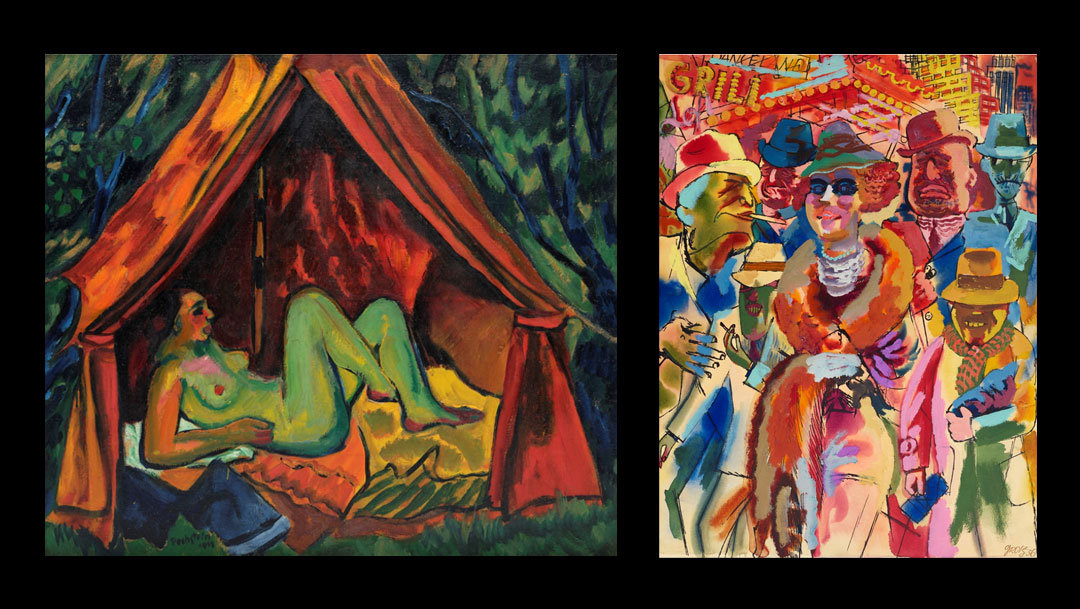
Image: Max Pechstein, “Rotes Zelt mit weiblichem Akt: Danae” (1911) · George Grosz, “Broadway (recto); Havana cigars (verso)” (1936)
As mentioned above, the day auctions offer paintings with much less “hype” than the big evening auctions, so potential “bargains” can always be found. For example, “Danse de l’ours” (1913-14) is a small painting by Gino Severini, one of the leading figures of Futurism, which has a pre-sale estimate of between £500,000 and £800,000. Max Pechstein, one of the leading members of the “Die Brücke” group, is represented by “Rotes Zelt mit weiblichem Akt: Danae” -an excellent painting created in 1911, at the height of Expressionism, which should exceed its pre-sale estimate of £400,000-600,000- and “Morgensonne“, a striking landscape painted in 1929 (£550,000 – £800,000). “Broadway (recto); Havana cigars (verso)” is a sensational gouache/watercolour by George Grosz, painted in New York in 1936, which has a very modest estimate of £80,000-120,000. The estimate for the portrait of Renée Kisling painted by Moïse Kisling around 1928 (between £30,000 and £50,000) also seems conservative. In the contemporary art section, “Self Portrait as a Tree” (2007) is an enigmatic painting by Scott Kahn which has a pre-sale estimate of between £60,000 and £80,000.
20th century and contemporary art auction at Phillips London, 2 March 2023
Phillips joins the party with an auction led by two abstract works from the collection of Marcel Brient: “Mathis” (1983) by Gerhard Richter (pre-sale estimate £10-15 million), and “[no title]” (1984) by Willem de Kooning (pre-sale estimate £7-10 million, sold for £6.1 million). Both paintings share a problem and an advantage: on the one hand, the oversupply of similar works on the market (both Richter’s Abstraktes Bilds and de Kooning’s late abstractions are common in this type of auction) is overwhelming. But on the other hand, the fact that none of them has ever been on auction before is an undeniable point in its favour.
Cecily Brown‘s “Skulldiver II” (2006) comes to auction with a pre-sale estimate of between £1 million and £1.5 million, four times higher than when it was auctioned at Bonhams some seven years ago. The painting was sold for £2.2 million, a good deal for its owner. The aforementioned Caroline Walker is represented at the auction with “Threshold“, a painting from 2014 which has a pre-sale estimate of between £150,000 and £200,000. “Threshold” was sold for an excellent £927,100.
Follow us on:


